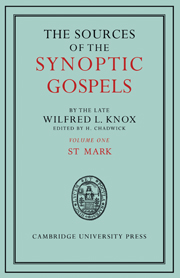Book contents
- Frontmatter
- Dedication
- Contents
- EDITOR'S PREFACE
- PREFACE
- ABBREVIATIONS
- INTRODUCTION
- I The first group of conflict-stories
- II The Twelve-source
- III Jesus and the devils
- IV The book of parables
- V Books of miracles
- VI Nazareth and John the Baptist
- VII Corban and miscellaneous incidents
- VIII A book of localized miracles
- IX The ‘Central Section’
- X The entry to Jerusalem
- XI A second group of conflict-stories?
- XII The warning against the scribes
- XIII The ‘Little Apocalypse’
- XIV The Passion story
- XV The Resurrection story
- SUMMARY
- INDEXES
INTRODUCTION
Published online by Cambridge University Press: 05 July 2014
- Frontmatter
- Dedication
- Contents
- EDITOR'S PREFACE
- PREFACE
- ABBREVIATIONS
- INTRODUCTION
- I The first group of conflict-stories
- II The Twelve-source
- III Jesus and the devils
- IV The book of parables
- V Books of miracles
- VI Nazareth and John the Baptist
- VII Corban and miscellaneous incidents
- VIII A book of localized miracles
- IX The ‘Central Section’
- X The entry to Jerusalem
- XI A second group of conflict-stories?
- XII The warning against the scribes
- XIII The ‘Little Apocalypse’
- XIV The Passion story
- XV The Resurrection story
- SUMMARY
- INDEXES
Summary
In 1921 Eduard Meyer pointed out that in Mark we have clear indications of the use of sources; the Gospel is not merely a compilation of anecdotes, but an attempt to bring into order a set of earlier records of the life and teaching of Jesus, which would be inevitably needed for the preaching of the Gospel. But by 1921 the star of form-criticism had already risen above the horizon, and in the fascinating exercise of fitting the stories of the Gospels into the various ‘forms’ of popular story-telling, and discovering situations in the supposed life of the early Church which might have led to the invention of a particular anecdote or saying, Meyer's warning was allowed to pass unheeded. Rawlinson dismisses his view on the ground of'the persistence throughout the Gospel of the very peculiar and characteristic Marcan mannerisms of style. The evangelist may have been using sources, but, if so, it is extremely unlikely that modern conjecture can succeed in determining what they were.'
The first objection raised by Rawlinson is quite beside the point. In most ancient historians we get a general uniformity of style, owing to the fact that the author has rewritten his sources more or less completely.
- Type
- Chapter
- Information
- The Sources of the Synoptic Gospels , pp. 1 - 7Publisher: Cambridge University PressPrint publication year: 2011



